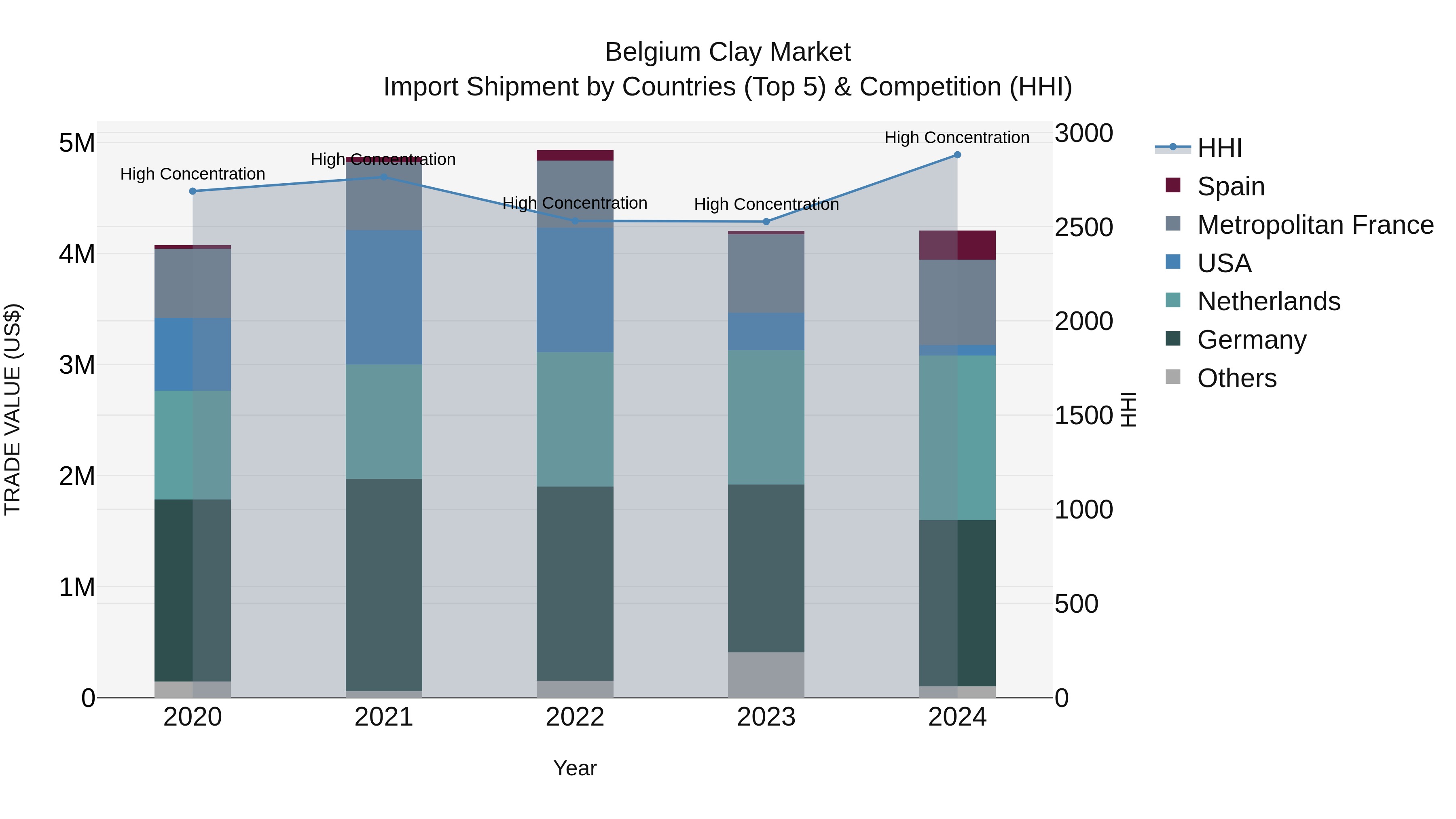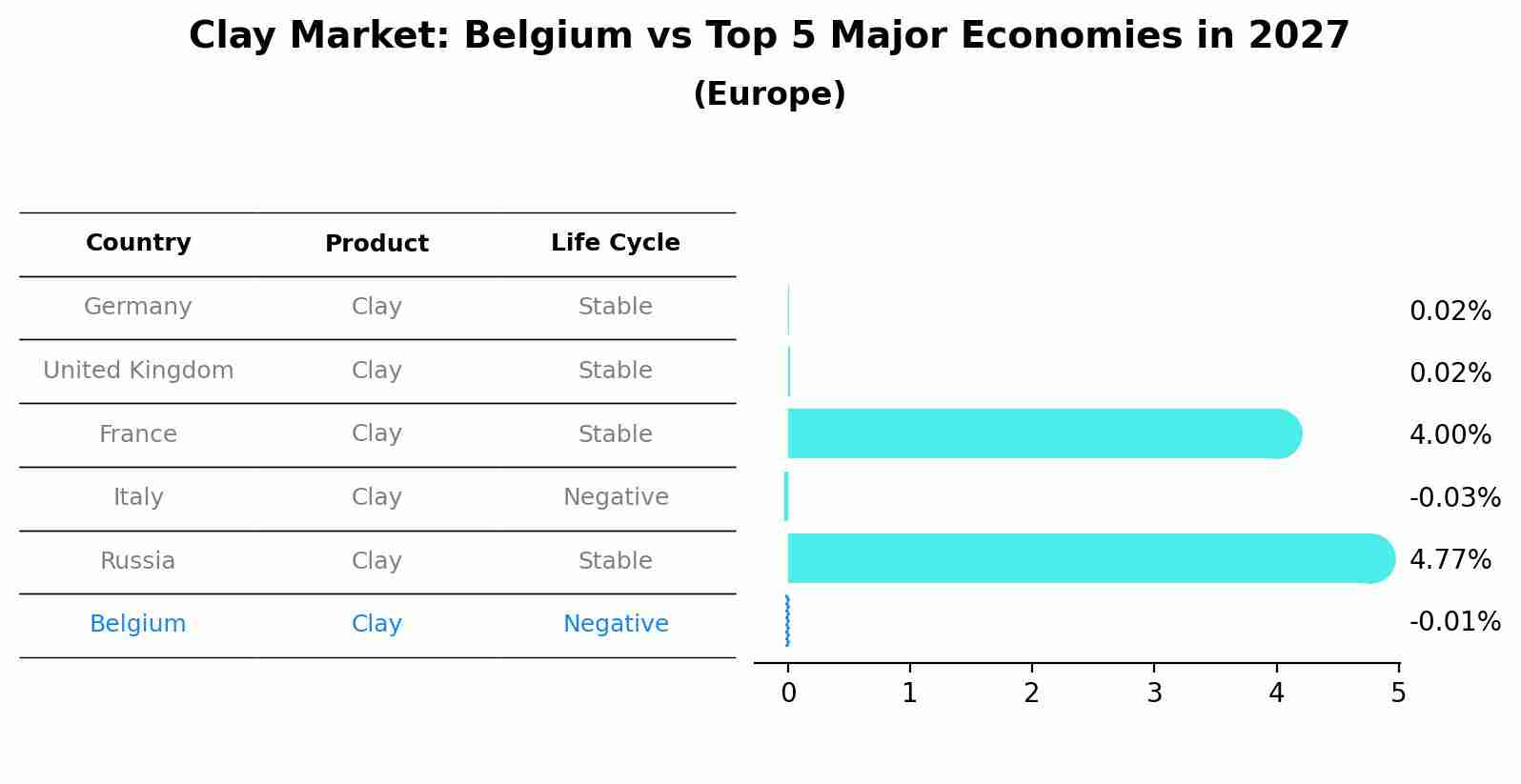Belgium Clay Market (2025-2031) | Trends, Revenue, Size, Companies, Analysis, Value, Outlook, Share, Forecast, Industry, Growth & Segmentation
| Product Code: ETC5257626 | Publication Date: Nov 2023 | Updated Date: Oct 2025 | Product Type: Market Research Report | |
| Publisher: 6Wresearch | Author: Bhawna Singh | No. of Pages: 60 | No. of Figures: 30 | No. of Tables: 5 |
Belgium Clay Market Top 5 Importing Countries and Market Competition (HHI) Analysis
Belgium continues to be a key importer of clay, with Germany, Netherlands, Metropolitan France, Spain, and the USA leading the pack in 2024. The high Herfindahl-Hirschman Index (HHI) indicates a concentrated market, while the modest Compound Annual Growth Rate (CAGR) of 0.8% from 2020-24 suggests stable demand. The slight uptick in growth rate from 2023-24 at 0.15% indicates a gradual increase in import volumes. Overall, Belgium`s clay import market remains steady with a consistent flow of shipments from top exporting countries.

Clay Market: Belgium vs Top 5 Major Economies in 2027 (Europe)
The Clay market in Belgium is projected to grow at a negative growth rate of -0.01% by 2027, highlighting the country's increasing focus on advanced technologies within the Europe region, where Germany holds the dominant position, followed closely by United Kingdom, France, Italy and Russia, shaping overall regional demand.

Belgium Clay Market Overview
The clay market in Belgium encompasses various types of clay used in industries such as ceramics, construction, and manufacturing. The market is influenced by the demand for ceramic products, including tiles, bricks, and pottery, as well as the use of clay in construction materials. Environmental regulations related to mining and processing, as well as fluctuations in raw material prices, impact the market. Innovations in clay processing and the development of new applications for clay products are also key factors.
Drivers of the market
The Belgium clay market is supported by the growing use of clay in various applications, including construction, ceramics, and agriculture. The demand for clay in the production of bricks, tiles, and pottery is a significant driver. Additionally, the use of clay in soil conditioning and as a raw material in industrial processes contributes to market growth. The increasing focus on sustainable and eco-friendly building materials also supports the demand for natural clay products.
Challenges of the market
The clay market in Belgium faces challenges related to environmental regulations and market demand fluctuations. The extraction and processing of clay are subject to stringent environmental regulations aimed at minimizing ecological impact. Compliance with these regulations can increase operational costs and complicate production processes. Additionally, the market experiences fluctuations in demand based on economic conditions and industry needs. Changes in construction activity, for example, can impact the demand for clay products. Companies must adapt to these fluctuations and find ways to optimize their operations and product offerings to remain competitive.
Government Policy of the market
The clay market in Belgium is affected by environmental regulations and standards governing the extraction and use of natural resources. The Belgian government enforces regulations to manage the environmental impact of clay mining and processing. These regulations include requirements for land reclamation and pollution control. Additionally, there are standards for the quality of clay used in various applications, such as ceramics and construction materials, which influence the market.
Key Highlights of the Report:
- Belgium Clay Market Outlook
- Market Size of Belgium Clay Market, 2024
- Forecast of Belgium Clay Market, 2031
- Historical Data and Forecast of Belgium Clay Revenues & Volume for the Period 2021-2031
- Belgium Clay Market Trend Evolution
- Belgium Clay Market Drivers and Challenges
- Belgium Clay Price Trends
- Belgium Clay Porter`s Five Forces
- Belgium Clay Industry Life Cycle
- Historical Data and Forecast of Belgium Clay Market Revenues & Volume By Application for the Period 2021-2031
- Historical Data and Forecast of Belgium Clay Market Revenues & Volume By Tableware for the Period 2021-2031
- Historical Data and Forecast of Belgium Clay Market Revenues & Volume By Sanitary ware for the Period 2021-2031
- Historical Data and Forecast of Belgium Clay Market Revenues & Volume By Medical applications for the Period 2021-2031
- Historical Data and Forecast of Belgium Clay Market Revenues & Volume By End Use for the Period 2021-2031
- Historical Data and Forecast of Belgium Clay Market Revenues & Volume By Ceramic and for the Period 2021-2031
- Historical Data and Forecast of Belgium Clay Market Revenues & Volume By Non-ceramic for the Period 2021-2031
- Belgium Clay Import Export Trade Statistics
- Market Opportunity Assessment By Application
- Market Opportunity Assessment By End Use
- Belgium Clay Top Companies Market Share
- Belgium Clay Competitive Benchmarking By Technical and Operational Parameters
- Belgium Clay Company Profiles
- Belgium Clay Key Strategic Recommendations
Frequently Asked Questions About the Market Study (FAQs):
1 Executive Summary |
2 Introduction |
2.1 Key Highlights of the Report |
2.2 Report Description |
2.3 Market Scope & Segmentation |
2.4 Research Methodology |
2.5 Assumptions |
3 Belgium Clay Market Overview |
3.1 Belgium Country Macro Economic Indicators |
3.2 Belgium Clay Market Revenues & Volume, 2021 & 2031F |
3.3 Belgium Clay Market - Industry Life Cycle |
3.4 Belgium Clay Market - Porter's Five Forces |
3.5 Belgium Clay Market Revenues & Volume Share, By Application, 2021 & 2031F |
3.6 Belgium Clay Market Revenues & Volume Share, By End Use, 2021 & 2031F |
4 Belgium Clay Market Dynamics |
4.1 Impact Analysis |
4.2 Market Drivers |
4.2.1 Increasing demand for sustainable construction materials |
4.2.2 Growth in infrastructure development projects in Belgium |
4.2.3 Technological advancements in clay processing techniques |
4.3 Market Restraints |
4.3.1 Fluctuating raw material prices |
4.3.2 Stringent regulations related to environmental impact |
4.3.3 Competition from alternative construction materials |
5 Belgium Clay Market Trends |
6 Belgium Clay Market Segmentations |
6.1 Belgium Clay Market, By Application |
6.1.1 Overview and Analysis |
6.1.2 Belgium Clay Market Revenues & Volume, By Tableware, 2021-2031F |
6.1.3 Belgium Clay Market Revenues & Volume, By Sanitary ware, 2021-2031F |
6.1.4 Belgium Clay Market Revenues & Volume, By Medical applications, 2021-2031F |
6.2 Belgium Clay Market, By End Use |
6.2.1 Overview and Analysis |
6.2.2 Belgium Clay Market Revenues & Volume, By Ceramic and, 2021-2031F |
6.2.3 Belgium Clay Market Revenues & Volume, By Non-ceramic, 2021-2031F |
7 Belgium Clay Market Import-Export Trade Statistics |
7.1 Belgium Clay Market Export to Major Countries |
7.2 Belgium Clay Market Imports from Major Countries |
8 Belgium Clay Market Key Performance Indicators |
8.1 Average selling price of clay products in the market |
8.2 Number of infrastructure projects utilizing clay materials |
8.3 Adoption rate of sustainable clay processing technologies |
8.4 Export volume of clay products from Belgium |
8.5 Customer satisfaction ratings for clay products |
9 Belgium Clay Market - Opportunity Assessment |
9.1 Belgium Clay Market Opportunity Assessment, By Application, 2021 & 2031F |
9.2 Belgium Clay Market Opportunity Assessment, By End Use, 2021 & 2031F |
10 Belgium Clay Market - Competitive Landscape |
10.1 Belgium Clay Market Revenue Share, By Companies, 2024 |
10.2 Belgium Clay Market Competitive Benchmarking, By Operating and Technical Parameters |
11 Company Profiles |
12 Recommendations | 13 Disclaimer |
- Single User License$ 1,995
- Department License$ 2,400
- Site License$ 3,120
- Global License$ 3,795
Search
Related Reports
- ASEAN and Thailand Brain Health Supplements Market (2025-2031) | Strategy, Consumer Insights, Analysis, Investment Trends, Opportunities, Growth, Size, Share, Industry, Revenue, Segments, Value, Segmentation, Supply, Forecast, Restraints, Outlook, Competition, Drivers, Trends, Demand, Pricing Analysis, Competitive, Strategic Insights, Companies, Challenges
- ASEAN Bearings Market (2025-2031) | Strategy, Consumer Insights, Analysis, Investment Trends, Opportunities, Growth, Size, Share, Industry, Revenue, Segments, Value, Segmentation, Supply, Forecast, Restraints, Outlook, Competition, Drivers, Trends, Demand, Pricing Analysis, Competitive, Strategic Insights, Companies, Challenges
- Europe Flooring Market (2025-2031) | Outlook, Share, Industry, Trends, Forecast, Companies, Revenue, Size, Analysis, Growth & Value
- Saudi Arabia Manlift Market (2025-2031) | Outlook, Size, Growth, Trends, Companies, Industry, Revenue, Value, Share, Forecast & Analysis
- Uganda Excavator, Crane, and Wheel Loaders Market (2025-2031) | Strategy, Consumer Insights, Analysis, Investment Trends, Opportunities, Growth, Size, Share, Industry, Revenue, Segments, Value, Segmentation, Supply, Forecast, Restraints, Outlook, Competition, Drivers, Trends, Demand, Pricing Analysis, Competitive, Strategic Insights, Companies, Challenges
- Rwanda Excavator, Crane, and Wheel Loaders Market (2025-2031) | Strategy, Consumer Insights, Analysis, Investment Trends, Opportunities, Growth, Size, Share, Industry, Revenue, Segments, Value, Segmentation, Supply, Forecast, Restraints, Outlook, Competition, Drivers, Trends, Demand, Pricing Analysis, Competitive, Strategic Insights, Companies, Challenges
- Kenya Excavator, Crane, and Wheel Loaders Market (2025-2031) | Strategy, Consumer Insights, Analysis, Investment Trends, Opportunities, Growth, Size, Share, Industry, Revenue, Segments, Value, Segmentation, Supply, Forecast, Restraints, Outlook, Competition, Drivers, Trends, Demand, Pricing Analysis, Competitive, Strategic Insights, Companies, Challenges
- Angola Excavator, Crane, and Wheel Loaders Market (2025-2031) | Strategy, Consumer Insights, Analysis, Investment Trends, Opportunities, Growth, Size, Share, Industry, Revenue, Segments, Value, Segmentation, Supply, Forecast, Restraints, Outlook, Competition, Drivers, Trends, Demand, Pricing Analysis, Competitive, Strategic Insights, Companies, Challenges
- Israel Intelligent Transport System Market (2025-2031) | Strategy, Consumer Insights, Analysis, Investment Trends, Opportunities, Growth, Size, Share, Industry, Revenue, Segments, Value, Segmentation, Supply, Forecast, Restraints, Outlook, Competition, Drivers, Trends, Demand, Pricing Analysis, Competitive, Strategic Insights, Companies, Challenges
- Uganda Precast and Aggregate Market (2025-2031) | Strategy, Consumer Insights, Analysis, Investment Trends, Opportunities, Growth, Size, Share, Industry, Revenue, Segments, Value, Segmentation, Supply, Forecast, Restraints, Outlook, Competition, Drivers, Trends, Demand, Pricing Analysis, Competitive, Strategic Insights, Companies, Challenges
Industry Events and Analyst Meet
Our Clients
Whitepaper
- Middle East & Africa Commercial Security Market Click here to view more.
- Middle East & Africa Fire Safety Systems & Equipment Market Click here to view more.
- GCC Drone Market Click here to view more.
- Middle East Lighting Fixture Market Click here to view more.
- GCC Physical & Perimeter Security Market Click here to view more.
6WResearch In News
- Doha a strategic location for EV manufacturing hub: IPA Qatar
- Demand for luxury TVs surging in the GCC, says Samsung
- Empowering Growth: The Thriving Journey of Bangladesh’s Cable Industry
- Demand for luxury TVs surging in the GCC, says Samsung
- Video call with a traditional healer? Once unthinkable, it’s now common in South Africa
- Intelligent Buildings To Smooth GCC’s Path To Net Zero













